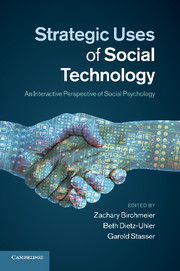Book contents
- Frontmatter
- Contents
- Figures
- Tables
- Notes on the contributors
- Acknowledgments
- 1 Introduction
- 2 A SIDE look at computer-mediated interaction
- 3 Trust, deception, and identity on the internet
- 4 An interactional approach to social influence in computer-mediated communication
- 5 Social interaction in cyberspace
- 6 Dynamics of leader emergence in online groups
- 7 Ostracism in cyberspace
- 8 Opinion-based groups
- 9 A juxtaposition of social influences
- 10 The virtual social world
- Index
- References
10 - The virtual social world
The continually changing landscape of social interaction
Published online by Cambridge University Press: 07 October 2011
- Frontmatter
- Contents
- Figures
- Tables
- Notes on the contributors
- Acknowledgments
- 1 Introduction
- 2 A SIDE look at computer-mediated interaction
- 3 Trust, deception, and identity on the internet
- 4 An interactional approach to social influence in computer-mediated communication
- 5 Social interaction in cyberspace
- 6 Dynamics of leader emergence in online groups
- 7 Ostracism in cyberspace
- 8 Opinion-based groups
- 9 A juxtaposition of social influences
- 10 The virtual social world
- Index
- References
Summary
When the lights go out in a kid's room, a familiar place can become many places – a strange land inhabited by frightening creatures or a playground of warm and fuzzy animals as playmates. The loss of visual cues permits the experience of a place to hinge on subtle cues – unfamiliar noises or the lingering fantasies of a bedtime story. The experience of social interaction is often shaped by place. When the sense of place is not well defined by a physical context, we, like the kid when the lights go out, can experience any one of many places, and our behaviors and the interpretations of others’ actions change depending on the place we construct. One of the emerging themes in this volume is that place is not well defined in computer-mediated interactions. In fact, the physical place is often irrelevant. The meaning of an e-mail exchange does not depend on whether the communicators are in their offices or at the local coffee shop when they send and receive the messages. Whether the exchange is viewed as a business negotiation or idle chit-chat depends less on where the communicators are located than on other cues, often subtle, associated with the interaction. Hence, physical place is often irrelevant to the definition of situation in the person x situation frame.
Another theme that threads its way through the chapters in this book is that the identity of the person is malleable. Actors’ identities are often partly or completely masked by the medium. Moreover, what one reveals about one's self is controllable and the opportunity for portraying a fraudulent self is great. I can become whomever my desires, imaginations, and ambitions dictate. Thus, anonymity has been and continues to be a variable of interest in the study of computer-mediated interaction. The emphasis in much of the early work was on the dark side of anonymous interactions – the bad things that happen when one escapes the constraints of norms and accountability. However, a sampling of the chapters in this volume reveals that the dark side is only part of the picture. For example, the social identity model of deindividuation effects (SIDE model; Spears et al., this volume) provides a much more nuanced and dynamic view of what can happen when actors’ identities are hidden or filtered by electronic media. Spears and his colleagues show how anonymity can lead to more or less normatively scripted behavior depending on the other cues in the context.
- Type
- Chapter
- Information
- Strategic Uses of Social TechnologyAn Interactive Perspective of Social Psychology, pp. 195 - 210Publisher: Cambridge University PressPrint publication year: 2011



